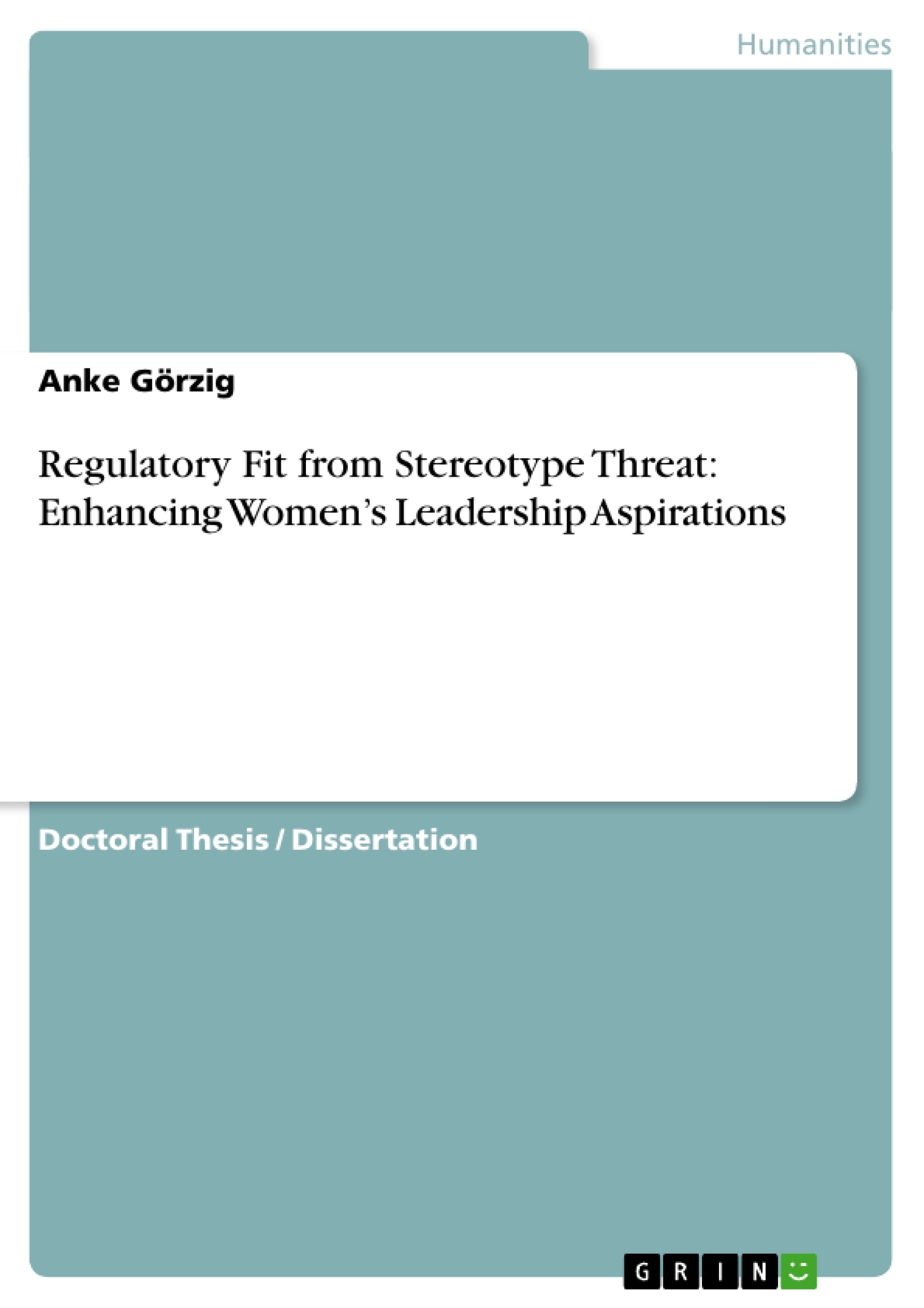A series of studies investigates the impact of regulatory fit on women’s leadership
aspirations. A regulatory fit occurs when an outcome is presented in gain frames
under a promotion focus and in loss frames under a prevention focus. Combining
research on regulatory focus and research on stereotype threat it is argued that
regulatory fit may result from stereotype threat (loss frame) under a prevention focus
and from the absence of stereotype threat (gain frame) under a promotion focus. In
line with previous research it is proposed that regulatory fit a) enhances motivation
(Studies 1 and 2) and b) creates a feeling right experience that increases the
persuasiveness of external stimuli (Study 3). In all three experiments regulatory fit
was operationalized as experiencing stereotype threat when under a prevention focus
or, respectively, experiencing the absence of stereotype threat when under a
promotion focus. Further, women’s aspirations to engage in a leadership role were
assessed. In Studies 1 and 2 it was shown that women’s motivation to occupy a
leadership role was enhanced in the regulatory fit conditions compared to women in
the nonfit conditions. Study 3 demonstrated that a stimulus (i.e., role model) was more
persuasive under regulatory fit. Women experiencing regulatory fit compared to
women in the nonfit conditions were more persuaded by role models, showing more
interest in a leadership role when confronted with a positive model and less interest
when confronted with a negative model. These studies show that stereotype threat can
elicit regulatory fit, which in turn affects women’s leadership aspirations. Future
directions and limitations are discussed.
Inhaltsverzeichnis (Table of Contents)
-
1 THEORETICAL PART
- 1.1 Stereotype Threat
- 1.1.1 Stereotype Threat and Performance
- 1.1.1.1 Paradigms
- 1.1.1.2 Underlying Processes
- 1.1.1.3 Consequences
- 1.1.1.4 Coping Mechanisms and Interventions
- 1.1.2 Stereotype Threat and Other Outcome Variables
- 1.1.2.1 Disengagement and Disidentification
- 1.1.2.2 Domain Aspirations and Motivation or Avoidance?
- 1.2 Regulatory Focus Theory
- 1.2.1 Paradigms
- 1.2.1.2 Moderators
- 1.2.1.3 Consequences
- 1.2.2 Regulatory Fit
- 1.2.2.1 Moderators
- 1.2.2.2 How and When Regulatory Fit Effects Emerge
- 1.3 Regulatory Fit from Stereotype Threat
- 1.3.1 Stereotype Threat and Regulatory Focus
- 1.3.2 Stereotype Threat and Regulatory Fit
- 1.3.2.1 Motivational Intensity and Performance
- 1.3.3 Summary of the Main Hypothesis and Experimental Overview
2 EMPIRICAL PART
- 2.1 Study 1
- 2.1.1 Method
- 2.1.1.1 Design and Participants
- 2.1.1.2 Procedure
- 2.1.2 Results and Discussion
- 2.1.2.1 Manipulation Check
- 2.1.2.2 Leader Role Motivation
- 2.1.2.3 Leadership Motivation – BIP
- 2.1.2.4 Test Performance and Effort
- 2.2.1 Method
- 2.2.1.1 Design and Participants
- 2.2.1.2 Procedure
- 2.2.2 Results and Discussion
- 2.2.2.1 Manipulation Check
- 2.2.2.2 Test Performance and Effort
- 2.2.2.3 Leader Role Motivation
- 2.2.2.4 Leadership Motivation - BIP
- 2.3 Discussion Study 1 and Study 2
- 2.4 Study 3
- 2.4.1 Method
- 2.4.1.1 Design and Participants
- 2.4.1.2 Procedure
- 2.4.2 Results and Discussion
- 2.4.2.1 Manipulation Check
- 2.4.2.2 Leadership Motivation
- 2.4.2.3 Impression Related Concerns and Pressure Related Feelings
- 2.4.2.4 Test Performance and Effort
Zielsetzung und Themenschwerpunkte (Objectives and Key Themes)
This dissertation investigates the impact of regulatory fit on women's leadership aspirations. The work aims to contribute to the understanding of how stereotype threat and regulatory focus interact to influence women's motivation and performance in leadership contexts.
- The influence of stereotype threat on women's performance and aspirations
- The role of regulatory focus theory in understanding stereotype threat effects
- The concept of regulatory fit and its application to leadership aspirations
- The influence of motivational intensity and performance under regulatory fit conditions
- The persuasive power of role models under regulatory fit
Zusammenfassung der Kapitel (Chapter Summaries)
The theoretical part of this dissertation provides a comprehensive overview of stereotype threat and regulatory focus theory. It discusses the concepts, paradigms, underlying processes, consequences, and coping mechanisms associated with stereotype threat. The chapter then introduces regulatory focus theory, exploring its theoretical framework, moderators, and consequences. It concludes by presenting the concept of regulatory fit, exploring its moderators and how it can be elicited from stereotype threat.
The empirical part presents the findings of three studies investigating the impact of regulatory fit on women's leadership aspirations. Study 1 and Study 2 assess the influence of regulatory fit on women's motivation to occupy a leadership role. Study 3 examines the persuasive power of role models under regulatory fit conditions.
Schlüsselwörter (Keywords)
The dissertation explores the key concepts of stereotype threat, regulatory focus, regulatory fit, leadership aspirations, motivation, performance, and role models. It investigates how these concepts interact to influence women's leadership aspirations and performance in challenging situations.
- Quote paper
- Dr. Anke Görzig (Author), 2008, Regulatory Fit from Stereotype Threat: Enhancing Women’s Leadership Aspirations, Munich, GRIN Verlag, https://www.grin.com/document/117798



